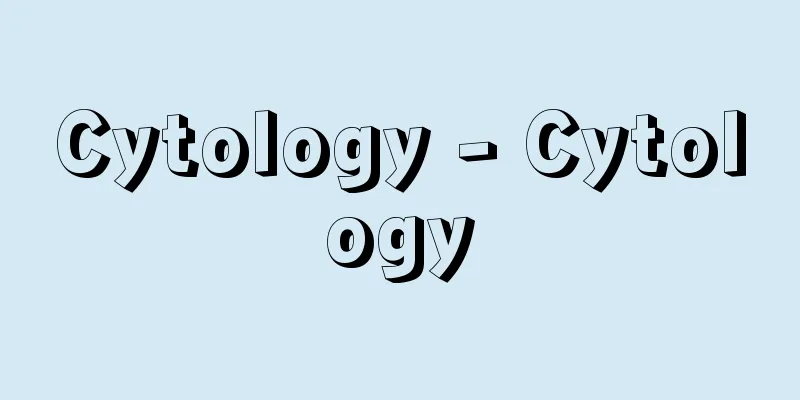Cytology - Cytology

|
This method involves exfoliating cells from the surface of tissue to examine for the presence or absence of cancer cells. It is also called cytology or exfoliative cytology. It is one of the most effective diagnostic methods for cancer of the digestive tract, bronchus, lungs, bladder, and uterus. It is said that microscopic examination was first used as a diagnostic method in the field of medicine in the early 19th century, but it was only in the 20th century that cytology was recognized as a clinical diagnostic method, thanks to the achievements of Greek-born American anatomist GN Papanicolaou (1883-1962). In 1925, he published a method for diagnosing pregnancy using cytology, and in 1928, he published a paper titled "Cells with a morphology characteristic of cancer," which set the precedent for cancer diagnostic methods. After that, over a dozen years, he compiled a method for diagnosing uterine cancer using vaginal smears. Since then, many researchers have worked to improve the techniques for collecting cells from various organs, fixing them, staining them, and other procedures. However, the staining method invented by Papanicolaou is still used as the standard method today, and the complexity of the method has been solved by the development of automatic staining devices. In order to incorporate cytology into mass screening for uterine cancer, stomach cancer, etc., cytology testing facilities and people who can select large numbers of cells are needed. Therefore, the Japanese Society of Clinical Cytology has responded by creating a system of cytology technicians together with cytology instructors. The criteria for determining whether a cell is cancerous based on a cytological examination include: (1) the nucleus is larger compared to the cytoplasm, (2) the nucleus is irregular and the nuclear membrane appears thickened, and (3) there are abnormal nuclear division images and the cell is often multinucleated. [Tadayoshi Takemoto] “Modern Obstetrics and Gynecology System 7D Cytology” by Junji Mizuno et al. (1972, Nakayama Shoten)” Source: Shogakukan Encyclopedia Nipponica About Encyclopedia Nipponica Information | Legend |
|
組織の表面から細胞を剥離(はくり)採取して癌(がん)細胞の有無を調べる方法で、細胞診断学、剥離細胞学ともよばれる。消化器癌のほか、気管支、肺、膀胱(ぼうこう)、子宮の癌の有力な診断法の一つである。医学の領域に顕微鏡検査が診断法として行われたのは19世紀初頭といわれているが、細胞診として臨床診断法の一つに認められたのは20世紀に入ってからで、ギリシア生まれのアメリカの解剖学者パパニコローG. N. Papanicolauo(1883―1962)の功績である。彼は1925年に細胞診による妊娠診断法を発表し、また28年には「癌に特有な形態をもった細胞」と題する論文を発表し、癌の診断法として先鞭(せんべん)をつけた。その後十数年かけて腟(ちつ)塗抹による子宮癌の診断法をまとめた。その後、数多くの研究者の努力によって、各種の臓器からの細胞の採取法や固定法、染色法などの手技について改良が行われた。しかし、今日でもパパニコローが考案した染色法が標準法として用いられており、その方法の煩雑さは自動染色装置のくふうによって解決をみている。子宮癌や胃癌などの集団検診の場に細胞診を取り入れるためには、細胞診検査施設とともに多数の細胞を選別する人が必要となる。そこで、日本臨床細胞学会では細胞診指導医とともに細胞診検査士の制度をつくって対応している。 なお、細胞診による癌細胞の判定基準としては、正常細胞に比べると癌細胞では、(1)細胞質に比して核が大きいこと、(2)核が不規則で核膜が肥厚してみえること、(3)異常な核分裂像があってしばしば多核になっていること、などがあげられる。 [竹本忠良] 『水野潤二他著『現代産科婦人科学大系7D 細胞診』(1972・中山書店)』 出典 小学館 日本大百科全書(ニッポニカ)日本大百科全書(ニッポニカ)について 情報 | 凡例 |
Recommend
Stephens, AS
…A cheap, popular novel that was popular in the U...
Tomono Sozen - Tomono Sozen
Year of birth: Year of birth and death unknown. A ...
DNA Ligase - DNA Ligase
An enzyme that joins gaps in one strand of double-...
Dischidia rafflesiana (English spelling) Dischidia rafflesiana
…[Ichiro Sakanashi]. … *Some of the terminology t...
Allophone
…These three sounds [ɸ][ç][h] all share the prope...
mémoires (English spelling)
...The former is an account of the author's o...
Saito Yakuro
A swordsman from the end of the Edo period. His n...
Ordo Cisterciensium Strictioris Observantiae
…a contemplative order of the Catholic Church. Si...
Airdox (English spelling)
A type of explosiveless blasting method used in pl...
Fushan
A Chinese calligrapher, painter and poet from the...
Ekishu County - Ekishu County
…The Records of the Grand Historian states that t...
Rochus
A Christian saint who lived from about 1295 to abo...
Kim Dae-jung
South Korean politician and 15th president. Born ...
Slavic People's Conference - Slovanský sjezd (English spelling)
The first ever general congress of the Slavic peop...
Trio Los Panchos
A Mexican trio that sings while playing the guitar...









